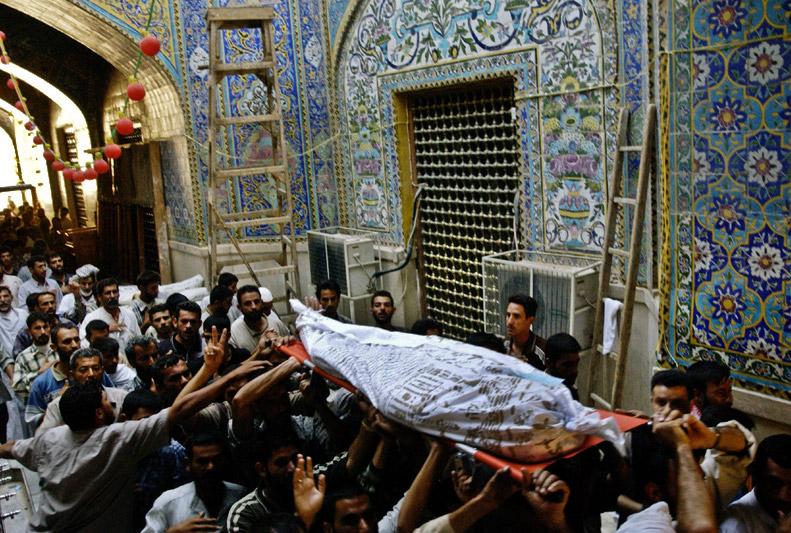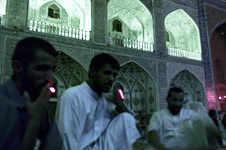
Najaf, Iraq, 18 August 2004. Fighters carry the body of a slain comrade around the tomb of Imam Ali three times, shouting, "There is no god but God." The martyred men are believed to be in paradise where there is no corruption or poverty.
Photo: Thorne Anderson, Corbis.
"Now, tell me, who is the woman you were talking to at the Hamra pool a few days ago?"
"Which woman?"
"The pretty one, the blonde one." Fatah was talking about Kael.
"I don't know who you mean."
"I know that you know her, she smiled at you. Remember? I saw you."
"I still don't know who you're talking about, Fatah. I'm sorry."
"Her husband, you know him?"
"No. I don't know them."
"Where are they from? Which country? Who do they work for?"
"I don't know who you are talking about, they are not my friends, Fatah."
"I think they are your friends, she smiled at you, the pretty one at the pool. I saw her."
"Maybe she smiled, Fatah, I say hello to everyone."
"You know her but you will not say." Fatah laughs. His lieutenants are watching me.
"That is not the case. I just don't know her."
"If you are afraid you can leave now. But if you are very afraid, then there is certainly some problem, and then I cannot save you."
"I am not afraid."
Fatah smiles, because he knows fear when he sees it.
"Should we eat?" He calls the waiter over.
When I left Sadr City that night, we drove out through a maze of roadblocks formed by lines of burning fuel. Mahdi Army fighters were out pouring gasoline on the ground and setting it ablaze. When the asphalt melted, they dug shallow trenches and filled them with artillery shells. All the bombs were being laid at night. Fighters would wait for a U.S. patrol to drive down the road, then detonate the roadside bomb from a nearby market stall or house. On the way out of Sadr city, I noticed that Mahdi Army checkpoints had appeared at every major street and intersection. We were stopped and questioned by nervous fighters, all of them looking for spies. The Mahdi Army was sowing Sadr City with explosives.
Back at the Dulaime, I spoke to Thorne and Kael about the Fatah interrogation and his involvement in the attack on Cho, as news of the Shiite uprising poured out of the television. Cho, recovering from the pistol-whipping, made plans to leave the country after talking to the South Korean embassy officials. The innocent period in Baghdad was over, and I found that I couldn't easily write or work. I quickly suspected everyone of spying on us, especially drivers and translators. I stopped talking to Iraqis.
Meanwhile, Najaf was besieged by U.S. forces and the few western reporters who had found a way of getting into the old city didn't stick around. I drifted around the hotel in Baghdad, falling into a deep depression, which lasted nearly two weeks. I felt locked out of Najaf where I had good contacts among the senior leadership of the Mahdi Army. All the time spent in the Shiite holy city seemed wasted, and I'd missed the chance to get inside when the door was still open. I became a prisoner of the Dulaime, paralyzed and bitter.
To the Shrine
After August 5, 2004, U.S. forces closed in on the old city of Najaf, but it was not a lightning attack. Elements of the First Cavalry Division sealed off major roads to the necropolis on the north side of town and began pushing south toward the Shrine of Imam Ali. Marine units moved in from the south and sealed off Medina Street. Apache attack helicopters began launching attacks from the floodplain in the west called the Najaf Sea. At the very start of the siege, residents of Najaf heard loudspeaker announcements telling them to leave the city, which sparked an exodus to the outlying suburbs. Within hours, most of the city was empty except for Mahdi Army soldiers and clerics loyal to Moqtada al Sadr. U.S. forces formed an unbroken ring outside the old city with the Shrine at its center. Young men loyal to Moqtada al Sadr poured into Najaf to reinforce the fighters. They had little equipment except their faith in God.
Most of the press was holed up in a hotel outside the U.S. cordon, too far away to see anything but flashes of light from the pitched battle in the cemetery. We watched BBC broadcasts that were little more than a rehash of what U.S. military commanders were saying. What was happening at the center of the Mahdi Army movement, inside the universe of the shrine was hidden from view. No information was leaving the old city.
When Shiite Muslims enter the Shrine, they kiss the doorjambs of the great wooden gates to greet Imam Ali, whose spirit they believe resides there. Pilgrims speak to him as if he were alive. The shrine is thought to have healing powers and the old, the sick, the mad take shelter within its grounds. I had been there a number of times. In the spring, a friend named Abu Hussein invited me to the tomb. We walked through the gates across a great expanse of polished marble, which reflected the sun, to a smaller building, covered in gold plates. We took off our shoes and walked inside to an antechamber of green marble, whose walls and vaulted ceilings were tiled with thousands of mirrors. Men prayed, edged closer to the tomb. Imam Ali is entombed behind a silver screen, behind glass, in darkness. Pilgrims circle the tomb, running their hands over the silver, while pausing to kiss it and utter prayers. A twelve-year-old boy who was mentally ill, chanted verses from the Koran while the Pilgrims assented, prayed with him, kissed the tomb every few steps. This place is one of the most revered places on earth. Inside the tomb you feel surrounded by a collective consciousness that is dreaming of the past. Your image is reflected in ten thousand mirrored tiles that adorn the marble interior of the building. A few hundred feet away, more than a million people lie buried.
 LEAD IMAGE: 17 August, 2004, Najaf, Iraq. Young followers of Moqtada al Sadr inside the shrine of Imam Ali during the siege.
LEAD IMAGE: 17 August, 2004, Najaf, Iraq. Young followers of Moqtada al Sadr inside the shrine of Imam Ali during the siege.Photo: Thorne Anderson
© Phillip Robertson, 2009-2020.
